|
|
|
|
|
|
|
|
|
|
|
|
|
|
|
|
|
|
|
|
|
|
|
|
|
|
|
|
|
 |
 |
 |
 |
 |
 |
 |
 |
 |
 |
 |
|
 |
 |
 |
 |
 |
 |
 |
 |
 |
 |
 |
 |
|
|
 |
 |
 |
 |
 |
 |
 |
|
|
|
 |
 |
 |
| Manhattan is one Depression glass pattern that many people don`t recognize as 'Depression glass`. It doesn`t fit into the usual framework that so many of us think of when we hear the words 'depression glass.` It`s not delicate with fancy edges. There are no flowers or etching, and it`s most often found in crystal, not the 'typical` depression greens, yellows, blues and pinks. It looks 'too modern to be that old`, a discussion I`ve had about Manhattan with many of those poor non-collecting souls who are dragged along to glass shows. I have found that people who hate Depression glass, like the Manhattan pattern for all the things it isn`t: namely, 'typical depression glass.` (Now, we collectors know better than to even think such a thing. But as it`s nice of these folks to drive us to shows and wait while we examine every single piece of glass that`s there, let`s be a little tolerant…for now.) |
 |
|
|
 |
 |
 |
 |
 |
 |
 |
 |
 |
 |
 |
 |
 |
 |
 |
|
|
|
 |
 |
 |
| Manhattan was produced by Anchor Hocking from 1938 to 1943. Crystal is the most common color, though pink, ruby, green and iridescent were also made. With the exception of the 3-footed candy dish - and perhaps the sugar, creamer and relish insert - pink is difficult to find and expensive when you do find it. Tumblers are the only piece 'commonly` found in green or iridescent, and ruby production was limited to the 24-oz ball jug pitcher and the triangular relish inserts. You will also find Manhattan pieces with metal accessories such as handles and spoon holders. Other companies made the metal parts; Hocking only supplied the glass. |
 |
|
 |
 |
 |
 |
 |
 |
 |
 |
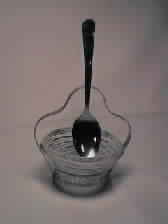 |
|
|
 |
 |
 |
 |
|
|
|
 |
 |
 |
| Color, though, is not nearly as much of a problem to Manhattan collectors as condition is. The Manhattan pattern is made up of concentric ribs. These ribs are pointed so that if you rub your fingernail across them, it will catch on each one and you can hear a little 'ting`. (The 'ting test` is one way to tell Manhattan from some look-alike pieces, though the ball jug pitcher is the exception, as it has rounded ribs.) Of course, this means that every piece of Manhattan is covered with edges. Add to this closed handles with ribs and pointed edges, and you have a chip waiting to happen. (As one frustrated collector said to me while examining the 14-inch relish tray, "The whole #*&$^ plate is an edge!") Manhattan pieces also tend to be heavy because of all the glass that went into making the ribs, and, although this adds to the potential for damage, many collectors feel this is part of its appeal. Because it`s not paper-thin, people are less nervous about using it around clumsy relatives. |
 |
|
|
 |
 |
 |
 |
 |
 |
|
|
|
 |
 |
 |
| There are a few pieces that can be confusing to new collectors. The 5 3/8 inch handled berry bowl is sometimes passed off as the 5 ¼ inch cereal bowl. Remember, the cereal bowl has no handles and sells for 3 times the price of the berry. The relish tray and inserts tend to cause confusion for a few reasons. First, the triangular relish inserts came in crystal, pink and ruby, while the 14-inch tray and the round center insert were only made in crystal. |
 |
|
 |
 |
 |
 |
 |
 |
 |
 |
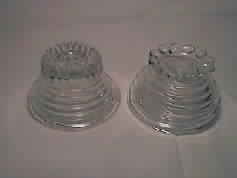 |
|
|
 |
 |
 |
 |
 |
|
|
|
 |
 |
 |
| (There are a lot of people out there looking for these pieces in color.) Second, the sherbet is often mistaken for the round insert. The sherbet has a beaded foot while the insert has straight ribs around the base. Last, the 14-inch plate also came divided into 4 parts. Try as you might, you can`t get all five triangular inserts to work in that four part tray. (Yup, people have complained about that one, too.) |
|
| Perhaps the hardest thing for the collector and novice alike, is the amount of ribbed glass that looks like Manhattan but isn`t. Anchor Hocking produced Park Avenue in 1987 as a deliberate look-alike for Manhattan. (Those clever marketing people recognized the modern appeal of the old pattern and found a way to capitalize on it.) Hocking was careful however, to maintain the integrity of the old glass by changing the shapes and colors of this new pattern. If you find a piece that you think is Manhattan but the measurements don`t match what you find in your Depression glass encyclopedia, you`ve got something else. |
 |
|
|
 |
 |
 |
 |
 |
 |
 |
 |
 |
 |
 |
 |
 |
 |
 |
 |
 |
|
|
|
 |
 |
 |
| There are some look-alikes, however, that were contemporary with the original Manhattan and have been used with it all along. Hocking made a decanter and water bottle that have the same rounded ribs as the ball jug pitcher, and many collectors include these as part of their collections. Hazel Atlas produced the covered candy jar and salt shaker pictured here. Both of these pieces are so widely accepted as "go-with" pieces that they`re included in the regular Manhattan listings. The reason for the shaker`s appeal is that the Hocking shaker is square and just doesn`t seem to fit in with all those concentric rings. This is also true for the candlestick, which was made from the same mold as the square ashtray and just doesn`t compliment the large open handled bowl the way the L.E. Smith double candlestick does. |
 |
|
 |
 |
 |
 |
 |
 |
 |
 |
 |
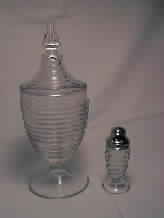 |
|
 |
 |
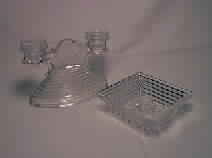 |
|
|
 |
|
|
|
 |
 |
 |
| Once in a while, in my hunt for pieces of Manhattan for my husband`s collection, interesting things have turned up. The green tumbler pictured above was a lucky find, as was the relish insert in the metal holder. The handled plate shown here, however, is our most intriguing find. It looks and feels like Manhattan, but the tab handles are unique. I knew I had seen a reference to it somewhere and finally came across it again: Hazel Marie Weatherman pictures this plate with a domed metal lid in the Supplement to Book 2, and calls it a butter dish. She was unable to find it in any Hocking listing, but thought it such a close relative to Manhattan that she named it "New York" Unless one turns up in its original box or an old advertisement, we`ll never know. |
 |
|
 |
 |
 |
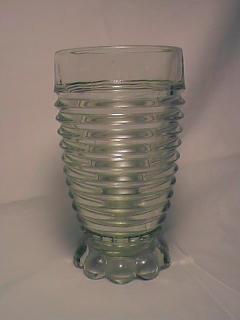 |
|
|
 |
 |
 |
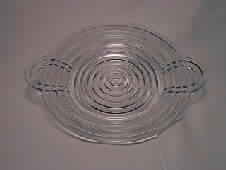 |
 |
 |
 |
 |
|
|
|
 |
 |
 |
| Finally, a warning: Heisey`s Ridgeleigh has been known to masquerade as Manhattan on more than one occasion. If you should see a piece hiding among the relish inserts, approach slowly, remove it carefully and try not to act too excited as they`ve been known to bolt. After all, paying Hocking prices for Heisey is one way to support your 'glass habit`! |
 |
|
|
|
 |
 |
 |
 |
 |
 |
 |
 |
 |
 |
 |
|
|






